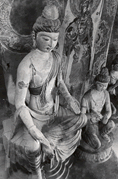A copy of the Lo Archive of about 2,500 black-and-white historic photographs of the Buddhist cave temples in Dunhuang, China, has been transferred to the Visual Resources Collection. Dunhuang, an oasis town on the edge of the Gobi
 desert in western China, was known as the "gateway" to the Silk Road, the route
of caravans that traveled westward across Asia to the eastern Roman Empire.
The nearly 500 caves at Dunhuang preserve about 2,000 sculptures and 45,000
square meters of wall paintings that range in date from the fourth to the thirteenth
century A.D. The caves' paintings, stucco sculpture, and scrolls represent every
stage of Buddhism, both doctrinally and artistically, during this long time
period. The paintings at Dunhuang are important not only because they chronicle
the development of Buddhism and Buddhist art along the Silk Road, but also because
they provide archaeological evidence for the development of Chinese painting
as a whole.
desert in western China, was known as the "gateway" to the Silk Road, the route
of caravans that traveled westward across Asia to the eastern Roman Empire.
The nearly 500 caves at Dunhuang preserve about 2,000 sculptures and 45,000
square meters of wall paintings that range in date from the fourth to the thirteenth
century A.D. The caves' paintings, stucco sculpture, and scrolls represent every
stage of Buddhism, both doctrinally and artistically, during this long time
period. The paintings at Dunhuang are important not only because they chronicle
the development of Buddhism and Buddhist art along the Silk Road, but also because
they provide archaeological evidence for the development of Chinese painting
as a whole. The photographs of the Dunhuang caves in Princeton's collection were made by James and Lucy Lo in the 1940s. Traveling partly on horseback, they arrived at Dunhuang in 1943 and began a photographic campaign that continued for eighteen months. Since no electricity was available, James Lo devised a system of mirrors and cloth screens that bounced light along the corridors of the caves to illuminate the paintings and sculptures.
The addition of this invaluable archive of photographs to the Visual Resources Collection ensures that it will be easily accessible to students and researchers. Lucy Lo has collaborated with ARTstor to make the Lo photographs of the Dunhuang caves available in digital format through ARTstor's Web site.